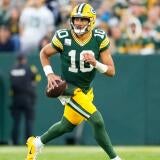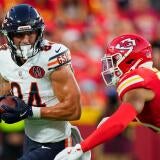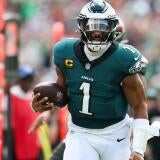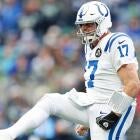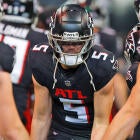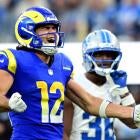Agent's Take: The definitive Super Bowl 2022 tale of the financial tape for Bengals vs. Rams
A big disparity exists between the two Super Bowl 56 teams when you look at adjusted salary caps

There isn't a right or wrong way to allocate financial resources in putting together a team that has Super Bowl potential. A specific blueprint within the constraints of the salary cap doesn't exist. Financial resources can be allocated in a variety of ways.
The Bengals have upgraded the talent on the roster by being uncharacteristically aggressive in free agency over the last two years and hitting home runs with their most recent first-round picks. The Rams have taken a more unconventional approach by consistently trading away premium draft picks for highly productive proven commodities. The last time the Rams picked in the first round was 2016 when quarterback Jared Goff was taken with the first overall pick. The high-profile trades overshadow the fact the Rams still have made 45 draft selections since 2017 although none were earlier than 44th overall.
The following chart outlines the salary cap charges for the Bengals and Rams key contributors throughout the season at each position and on special teams. That's 29 players for the Bengals and 30 for the Rams. Both teams have 15 players on offense. The Rams have one more player on the defensive side of the ball than the Bengals, who utilized 14 players.
Dead money, a salary cap charge for a player no longer on a team's roster, is tracked as well. The NFL Collective Bargaining Agreement's $275 daily amount for participating in a team's voluntary offseason workout program is included in the cap numbers.
Financial tale of the tape
BENGALS | RAMS | |
QB | $8,231,356 | $20,000,000 |
RB | $9,876,913 | $4,362,591 |
WR | $17,436,731 | $13,323,359 |
TE | $7,841,376 | $6,415,600 |
OL | $20,898,485 | $14,476,265 |
EDGE | $16,854,552 | $10,559,590 |
DT | $21,951,825 | $23,151,263 |
LB | $2,262,869 | $1,735,034 |
CB | $28,780,739 | $15,576,865 |
S | $8,347,169 | $2,989,753 |
ST | $3,186,144 | $6,106,525 |
Dead money | $13,273,937 | $42,197,592 |
The NFL salary cap is currently $182.5 million. Each team's actual salary cap (known as adjusted salary cap) is typically different from the NFL's set amount because unused cap room can be carried over from one year to the next year and other adjustments can further increase or decrease cap space.
The league-wide average is $193,706,074, according to NFLPA data. The Rams are near the NFL's bottom as seven teams have a smaller adjusted salary cap than their $187,099,141. It will likely be the same for the 2022 league year because of a small carryover. Just $137,725 of the cap room wasn't used during the 2021 league year. The Bengals are slightly above league average with an adjusted salary cap of $195,138,275 and $5,292,742 is being carried over to the next league year.
Cincinnati's key-contributor cap spending skews to the defense. It's a little less than $64.275 million offensively to slightly under $78.2 million defensively. The difference can be attributed to the major free agent signings being on defense while the first-round picks are offensive players. Los Angeles has a more even distribution with just over $58.5 million on offense and slightly more than $54 million on defense.
Dead money
Dead money exists because of how salary cap accounting rules operate. Signing bonuses, option bonuses and certain roster bonuses are prorated or spread out evenly over the life of a contract for a maximum of five years. When a player is released, traded or retires, the remaining proration of these salary components immediately accelerate onto his team's current salary cap.
There are two major exceptions to this general rule of bonus proration accelerating. Only the current year's proration counts toward the salary cap with transactions occurring after June 1. The bonus proration in future contract years is delayed until the next league year beginning in the following March. A team can also release two players each league year prior to June 2 (known as a post-June 1 designation) that will be treated under the salary cap as if they were released after June 1. With a post-June 1 designation, a team is required to carry the player's full cap number until June 2 even though he is no longer a part of the roster. The player's salary comes off the books at that time unless it is guaranteed.
This means dead money is typically a sunk cost where money isn't owed to a player. Only if there are salary guarantees when a player is released will there be a payment associated with dead money.
A strict definition of dead money is being used. Any player who is still under contract, including practice squad members and those whose contracts voided and subsequently re-signed, are not in the calculations. For example, the Rams have a $3,333,334 cap charge because of the 2021 and 2022 contract years voiding from the one-year contract edge rusher Leonard Floyd signed in 2020. This $3,333,334 is part of Floyd's total cap charge because he returned to the Rams in free agency on a four-year contract averaging $16 million per year. It would have been part of Los Angeles' dead money if he had signed elsewhere.
The Rams had a higher degree of difficulty in roster construction because of excessive dead money. It would be in the $45.5 million neighborhood if Floyd's cap charge from his contract voiding had been included.
The $24.7 million cap charge the Rams have from trading quarterback Goff to the Lions is the second largest in league history. The Rams aren't strangers to big dead money charges. Wide receiver Brandin Cooks set the record for the most dead money related to an individual player for one league year in 2020 when the Rams dealt him to the Texans.
The $8.4 million in dead money for using a post-June 1 designation on running back Todd Gurley in March 2020 is significantly more than the Rams' combined cap charges for ball-carriers this league year. Other notable Rams dead money is for releasing wide receiver DeSean Jackson ($3,476,088) at midseason and because of an offseason trade of defensive lineman Michael Brockers ($2,666,667).
Cincinnati's dead money is about one-third of Los Angeles'. The only major dead money charges come from defensive tackle Geno Atkins' release ($5.2 million) and edge rusher Carlos Dunlap being dealt at the 2020 trading deadline ($2.225 million).
Offense
Quarterback
Matthew Stafford is in Los Angeles because Rams head coach Sean McVay wanted an upgrade at quarterback. McVay had soured on Goff last season despite him signing a four-year contract extension averaging $33.5 million per year with the Rams shortly before the 2019 regular season started. The Lions accommodated Stafford's request to be traded to a contending team. Goff was included in this trade where the Lions received a 2022 first-round pick, a 2023 first-round pick and a 2021 third-round pick from the Rams. The Rams have $44.7 million of the cap devoted to quarterback between Goff's dead money and Stafford's actual cap number.
A high-caliber quarterback on a rookie contract, like 2020 first overall pick Joe Burrow, is the most valuable commodity in the NFL because of the roster flexibility it can provide. Stafford's $20 million cap number is almost two-and-a-half times as much as Burrow's, which is just over $8.25 million. The Bengals will have at least one more year where Burrow has a cost-effective cap number because he doesn't become eligible for a contract extension until the 2022 regular season has concluded.
Running back
Joe Mixon is one of eight NFL running backs with a deal averaging $12 million per year or more. He signed a four-year, $48 million extension as the start of the 2020 regular season was approaching. Mixon has the league's fourth-largest running back cap number ($8,420,558). It's almost twice as much as the collective cap numbers of Los Angeles' backfield combination (Cam Akers, Darrell Henderson and Sony Michel).
Wide receiver
Cincinnati has the biggest individual wide receiver cap number with Tyler Boyd ($9.85 million). That's because salary conversions to get under the salary cap before the league year started last March lowered Cooper Kupp and Robert Woods' 2021 cap numbers from $14.5 million and $13.875 million to $5.3 million and $5.875 million, respectively.
The Bengals may possess the league's best wide receiver trio with Boyd, 2021 NFL Offensive Rookie of the Year Ja'Marr Chase and 2020 second-round pick Tee Higgins ($1,980,595 cap number). Chase, 2021's fifth overall pick, has a $5,606,136 cap number.
The Rams are the only NFL team that has two wide receivers with contracts averaging at least $15 million per year. Kupp and Woods signed three- and four-year extensions averaging $15.75 million and $16.25 million per year in September 2020.
Odell Beckham's signing in November after being released by the Browns was viewed as a luxury, not a necessity, for the Rams. That quickly changed with Woods tearing the ACL in his left knee during a practice before the ink was barely dry on Beckham's contract.
The Rams only have an $850,000 cap charge for Beckham because the contract he signed with a base value of $1.25 million ($750,000 in base salary and a $500,000 signing bonus) worth up to $4.25 million through incentives has four voiding/dummy years, so the signing bonus is prorated through 2025. The Rams will have a $400,000 cap charge in the 2022 league year because of the bonus proration for the 2022 through 2025 contract years when these years void on Feb. 21.
Beckham's $3 million of incentives are tied to the Rams' playoff success. He earned $500,000 for a wild card game win against the Cardinals. Beckham made another $750,000 each for divisional playoffs and NFC Championship Game victories over the Buccaneers and 49ers. There's an additional $500,000 for making it to the Super Bowl and $500,000 more for winning. All of the incentives are also predicated on Beckham being on the game day active roster and participating in at least one offensive play for that particular contest.
Tight end
Both starting tight ends come into the game with knee injuries sustained in the conference championship games. Bengals tight end C.J. Uzomah is more likely to play than his Rams counterpart Tyler Higbee. The bigger cap number belongs to Uzomah, whose $6,333,334 figure ranks sixth among tight ends for 2021.
Offensive line
Neither team has big individual cap charges on the offensive line. There aren't any offensive linemen with contracts averaging $10 million per year or more for the participants. Each team having multiple starters on rookie contracts is a contributing factor. The largest cap number belongs to Cincinnati center Trey Hopkins ($6.575 million) thanks to Rams right tackle Rob Havenstein's contract restructure and their 40-year-old left tackle Andrew Whitworth taking a $5.5 million pay cut to $4 million.
Incentives gave Whitworth an opportunity to earn back $4.5 million of the $5.5 million. Whitworth made $3 million because his offensive playtime for the 2021 regular season hit 54% and the Rams' NFL ranking improved in either points scored, average net yards per passing play or average net yards per rushing play. His playtime was 85.03%.
Whitworth also has incentives based on the Rams' playoff success and his offensive playtime reaching 65%. He got $500,000 for making the playoffs. Winning one playoff game was worth $500,000 more. There's another $500,000 with a Super Bowl victory.
Whitworth's 2022 base salary increased by $1 million for the Rams' postseason berth and did another $500,000 with a playoff win. The playtime requirement for the salary escalator was 75% instead of 65%.
Defense
Edge rusher
There are three players with contracts averaging at least $15 million per year between the two teams. Trey Hendrickson was signed to a three-year, $45 million contract last March as an unrestricted free agent to help address an anemic Bengals pass rush. The Bengals ranked last in the NFL during the 2020 season with 17 sacks. Cincinnati's sack total increased to 42 this season.
Floyd remained with the Rams by signing a four-year, $64 million contract. His $8,841,034 cap charge, which includes the $3,333,334 from his 2020 contract voiding, ranks fourth on the Rams.
Acquiring Von Miller for 2022 second- and third-round picks just ahead of the Nov. 2 trading deadline has given the Rams' pass rush a boost. The six-year contract averaging $19,083,333 per year that made Miller the NFL's highest-paid non-quarterback in 2016 is expiring. Miller's cost to the Rams is minimal. He has a $722,222 cap charge because the Broncos converted $9 million of the Super Bowl 50 MVP's remaining $9,722,222 2021 base salary into a signing bonus prior to the trade.
Defensive tackle
Both teams have devoted substantial resources to the interior of their defensive line. The interior defensive line cap charges are relatively equal.
Three-time NFL Defensive Player of the Year Aaron Donald became a charter member of the $20 million-per-year non-quarterback club in 2018. He was the first to break the barrier when the Rams gave him a six-year, $135 million extension ($22.5 million per year) with $86.892 million of guarantees. His $40 million signing bonus is the largest ever for a non-quarterback.
Donald's $27.892 million 2021 cap number was the biggest for an NFL interior defensive lineman before turning $18 million of his $19.892 million base salary into signing bonus to create $13.5 million of cap room. It's now third.
D.J. Reader set the market for run-stuffing interior defensive linemen when Cincinnati signed him to a four-year, $53 million deal averaging $13.25 million per year in 2020 free agency. His $13,562,500 cap number is the second largest on the Bengals and fourth in the NFL for interior defensive linemen.
Linebacker
There is a nominal investment in linebacker with both teams. The key players are on rookie contracts. The combined cap charges of Bengals' Germaine Pratt and Logan Wilson as well as Rams' Ernest Jones and Troy Reeder are less than $4 million. Pratt has the biggest cap number at $1,132,546. All but Reeder were third-round picks. Reeder went undrafted in 2019.
Cornerback
The Bengals overhauled this position through free agency. The biggest cap expenditures for any position are at cornerback.
Trae Waynes has the largest cap number on the Bengals at $15,858,823. He signed a three-year, $42 million contract in 2020. Waynes is being included although his only action in the playoffs has come on special teams. He was limited to five regular-season games (with four starts) because of a hamstring injury. Waynes has been a disappointment largely because of injury. He missed the entire 2020 season with a torn pectoral muscle.
Cincinnati has gotten a better return on its investment with the 2021 free agency signings. Chidobe Awuzie played at a Pro Bowl level after signing a three-year, $21.75 million deal. Mike Hilton has been well worth the four-year, $24 million contract given to him to cover slot wide receivers. Eli Apple has outperformed his one-year, $1.2 million deal worth up to $1.6 million through incentives.
The Rams gave up a 2020 first-round pick, a 2021 first-round pick and a 2021 fourth-round pick to acquire Jalen Ramsey from the Jaguars during the middle of the 2019 season. The five-time Pro Bowler became the NFL's first and only $20 million per year defensive back right before the start of the 2020 regular season. Ramsey signed a five-year, $100 million extension worth up to $105 million through salary escalators. He also set records for cornerbacks with $43.703 million fully guaranteed at signing and $71.203 in total guarantees.
The Rams thought highly enough of Darious Williams to make him the NFL's only 2021 restricted free agent to receive a first-round tender of $4.766 million. The Super Bowl is probably going to be the impending unrestricted free agent's last game with the Rams.
Safety
The only key player on a veteran contract is Bengals safety Vonn Bell, who signed a three-year, $18 million deal in 2020 free agency. Jessie Bates is a prime candidate to be designated as a franchise player by the Bengals. The 2022 safety number projects to $12.911 million (6.201% of the expected $208.2 million 2022 salary cap).
Bates' $2,858,928 cap number is almost as much as the Rams' combined cap charges for safeties. Jordan Fuller, Taylor Rapp and Nick Scott were drafted in 2020's sixth round, 2019's second round and 2019's seventh round, respectively. An ankle injury in the regular-season finale against the 49ers has landed Fuller on injured reserve. Rapp hasn't played since he suffered a concussion in the same game. He will be available to play in the Super Bowl.
The injuries necessitated the Rams pulling Eric Weddle out of a two-season retirement for the playoffs. There isn't a cap charge for Weddle since his signing occurred after the regular season. Postseason pay comes from a league pool instead of being based off individual contracts, unless there are specific incentives relating to the playoff performance.
Special teams
The Rams' special teams cap expenditures are nearly twice of the Bengals. Rams punter Johnny Hekker was the NFL's highest-paid punter at $3.75 million per year before taking a pay cut in a reworked three-year contract with a $2,583,333 average yearly salary. He still has 2021's largest punter cap number at $4,394,700.
The kickers are tremendous bargains. The Bengals were criticized for selecting Evan McPherson in 2021's fifth round. He was the only kicker taken in the 2021 NFL Draft. McPherson's clutch kicking in the playoffs has made him the most important fifth-round pick selected in 2021.
Matt Gay, a 2019 fifth-round pick who was released by the Buccaneers in the 2020 roster cutdowns, played this season for his $850,000 league minimum salary. He will likely receive a second-round restricted free agent tender for a projected $3.986 million after earning Pro Bowl honors this season.


